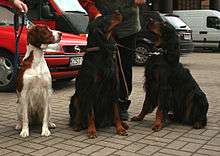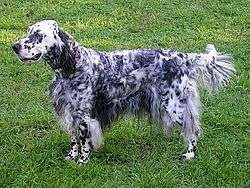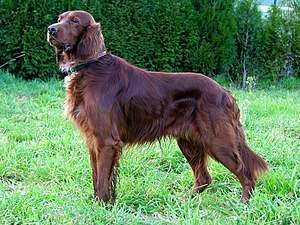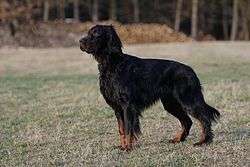Setter
The setter is a type of gundog used most often for hunting game such as quail, pheasant, and grouse.
In the UK, the four setter breeds, together with the pointers, usually form a subgroup within the gundog group as they share a common function. However, the setter breeds each have subtle differences in head, bone and substance.[1]
The American and Canadian Kennel Clubs classify these breeds within the Sporting Group.[2][3] Setters from show lines are usually considered to be heavier and larger than those from 'working' lines.[4][5][6]
Function
A setter silently searches for game by scent; hunting is done systematically and methodically. When prey is encountered, the dog becomes motionless rather than chasing after the game. Setters get their name from their distinctive stance; a sort of crouch or "set" upon finding their quarry. Once the dog has indicated where the birds are by freezing on point, the birds are then flushed so the following guns can get a shot. In earlier times before guns were used, a net would be used to trap the birds.[6]
The scent of game birds is airborne, so to sense it, the setter carries its head high and should never follow foot scent.[6] Most setters are born with a natural proclivity to hunting. Dogs which show excitement and interest in birds are described as being "birdy", and trainers look for puppies that show this particular trait. Training is usually done with quail as a first choice or domesticated pigeons.[7]
Attributes
This group of dogs combines beauty, brains and bird sense; the early setter breeds are believed to have been developed as far back as the 15th century in the UK.[8] The ancestors of modern setters probably originated in Spain and were bred from spaniel stock. Later, these dogs were exported to France and England where the breeds were developed into today's varieties.
They are fast, stylish game-finding dogs with a unique history and evolution for the single purpose of finding game birds.[9] Writing in 1576 Dr Johannes Caius states "There is also at this date among us a new kind of dogge brought out of Fraunce, and they bee speckled all over with white and black, which mingled colours incline to a marble blewe". Argue speculates this may be a description of the blue belton colour found in English setters.[9]
.jpg)
Early shows and field trials

The first official dog show held in the UK was at Newcastle-on-Tyne in June 1859 and entry was restricted to setters and pointers. There were 36 setters and 23 pointers entered. The show was organised by John Shorthose and William Pape. Mr Jobling's Black and Tan Setter, Dandy, won the first prize for setters. The class for pointers was judged by Mr Jobling who awarded the prize to a pointer owned by a Mr Brailsford, who helped judge the setters. This raised some criticism.[10]
The prize awarded to each winner was a double barrelled gun worth around £15 to £20.[11]
There was uncertainty as to how setters would be classified at early shows. Three classes were usually scheduled in 1862 dividing setters into three categories: English, Black/Tan and Irish. These became official breed classifications when The Kennel Club was founded in 1873.[10]
During 1806 in the UK there was a sale of setters. A black setter bitch called Peg was sold for 41 guineas while the price for setter dogs called Punch, Brush, Bob, Bell, Bounce and Sam varied from 17 to 32 guineas each. No colours were specified for the dogs.[12]
The first recorded field trial in the UK was held in April 1865 on the estate of Samuel Whitbread (MP) at Southill, Bedfordshire.[13] It was only open to setters and pointers. All the setters entered were black and tans (Gordons).[14]
In 1879, the Western Hemisphere held its first recorded show. This was also restricted to setters and pointers. It was four years after this that the first American Field trial was held.[15]
More recent competitions
The Kennel Club has four champion titles available to be achieved by setters competing in the UK. These are:
- Show Champion (Sh Ch), awarded to dogs who have won three Challenge Certificates (CCs) under three different judges with at least one CC won after 12 months of age
- Champion (Ch), gained by dogs which have won a Sh Ch title plus a field trial award, Diploma of Merit or a Show Gundog Working Certificate
- Field Trial Champion (Ft Ch), dogs which won a pointer or setter open stake or two first prizes at two different stakes under two different A Panel judges; there must be no less than 16 runners entered.
- Dual Champion, the highest award available to setters, a dog which has achieved the titles of Show Champion and Field Trial Champion.[16]
Challenge Certificates were first introduced by the Kennel Club in December 1900. Prior to 1958, a gundog could not claim to be a champion no matter how many CCs it won until it had gained a qualifier in the field as well. When the Show Champion title was instigated in 1958, it was agreed this could be applied retroactively.[17][18]
The first ever gundog to attain the title was an English Setter.[19] Since the Second World War only two dogs have achieved Dual Champion status in the UK. The first was a Pointer and the second was a Gordon Setter, the only Gordon to ever achieve this accolade.[20][21]
Setters have been Best in Show at Crufts seven times. The award was secured by Irish Setters in 1981,[22][23] 1993, 1995[24] and 1999.[24] English Setters were best in show in 1964,[23] 1977 and 1988.[23] The Irish Setter Best in Show of 1981 was already a Field Trial Champion, proving that she had brains as well as beauty.[25]
At the Westminster show in America an English Setter won the Best in Show title in 1938. He was only 11 months old and at his very first show.[26] This was before entry to the show was restricted to Champions in 1992.[27] He is the only setter to achieve Best in Show at Westminster.[28]
Registrations
In January 2006, the Kennel Club identified a number of British native breeds registering 300 or fewer puppies each year; it labelled these breeds as 'Vulnerable Native Breeds'.[29] Initially, the list included the Irish Red and White Setter and the Gordon Setter but Gordons were re-classified as viable in January 2007 after consultation with the breed clubs.[30] English Setters were added for the first time in 2012.[31]

To give an indication of how the UK registrations have changed, English Setter registrations were 568 in 2002, Gordons were 250 and Irish Red and Whites were 99, but Irish registrations totalled 1,225. However, by 2011 the figures for English Setters dropped to 234 puppy registrations; Gordons had a slight increase to 306; Irish Red and Whites had a slight drop to 83; and Irish decreased to 869 puppy registrations.[32]
In contrast, in a comment about registration figures and popular breed rankings, the American Kennel Club stated that 2011 was the "year of the setters, with all four making big jumps over the past year".[33] English Setters had ranked at 101 in 2010 but moved up to 87 in 2011; Irish had shifted from ranking at 77 in 2010 to 70 in 2011; Irish Red and Whites went up three places having been 150 in 2010 and 147 in 2011; and Gordons improved its 2010 position of 98 to be ranked at 94.[33]
On January 1, 2009, the Irish Red and White setter became eligible for American Kennel Club registration and was thereafter able to compete in the Sporting Group at its shows.[34]
Coat
Most setter breeds have long smooth, silky coats that require maintenance.[35] While Gordon, Irish and English Setters usually undergo some trimming for presentation in the show ring, Irish Red and White Setters do not require as much work, because they have lighter coats.[36]
Temperament
Setters have a tendency to be happy, playful dogs and are usually very friendly both to people and other dogs. They have a great deal of energy and require daily exercise.[35]
Setter breeds
The breeds making up this subgroup are:
- English Setter
- Gordon Setter
- Irish Setter (a.k.a. Irish Red Setter)
- Irish Red and White Setter
References
- Footnotes
- Kane (2009): pp. 77, 87
- "AKC Breeds by group - sporting". American Kennel Club. Retrieved 20 October 2012.
- "CKC Breeds & Abbreviations, Group 1, Sporting". Canadian Kennel Club. Retrieved 20 October 2012.
- Lester, Paula. "Save our English Setters". Country Life. Retrieved 16 October 2012.
- Rawlings, Paul. "Bench and Field: How wide is the divergence between show and field trial dogs?". Dog World. Retrieved 16 October 2012.
- Roberts (1978): pp. 114-116
- Truman (1993): pp. 79, 83
- Harper (2001): p. 9
- Argue (1993): pp. Introduction, 28
- Foss, Valerie. "Is this the first show winner?". Dog World. Retrieved 7 October 2012.
- Sutton (1980): p. 27
- Cunliffe (2001): p. 17
- Sutton (1980): p. 28
- Cunliffe (2001): p. 14
- Harper (2001): p. 17
- "Regulations for entries in the Stud Book, Champions and Warrants" (PDF). The Kennel Club. Archived from the original (PDF) on 16 October 2012. Retrieved 7 October 2012.
- Morland Hooper (1975): p. 119
- Bengston (2008): p. 233
- Cunliffe (2001): p. 15
- "Only dual champion Gordon dies". Dog World. Retrieved 7 October 2012.
- McDonald, Christine. "First Dual Ch Gordon". ourdogs.co.uk. Our Dogs. Retrieved 7 October 2012.
- Dogworld, Digital Crufts ed. (2010): pp. 80–89
- Jackson (1990)
- Dogworld, Digital Crufts ed. (2010): p. 89
- Williams (2000): p. 17
- "1 of 3,093". Time. 21 February 1938. Retrieved 11 April 2010.
- Fernandez, Amy. "This Year's Top Dogs". Dogchannel.com. Archived from the original on 23 September 2015. Retrieved 9 October 2012.
- "Best in show winners". westminsterkennelclub.org. Westminster Kennel Club. Retrieved 9 October 2012.
- "An introduction to the Vulnerable Native Breeds". The Kennel Club. Retrieved 9 October 2012.
- "Native Vulnerable Breeds". The Kennel Club. Archived from the original on 9 March 2013. Retrieved 9 October 2012.
- Rincon, Paul (25 January 2012). "UK native dog breeds 'at risk of extinction'". BBC. Retrieved 9 October 2012.
- "Comparative tables of registrations for the years 2002 - 2011 inclusive" (PDF). The Kennel Club. Archived from the original (PDF) on 31 May 2012. Retrieved 14 October 2012.
- "AKC Dog registration Statistics". American Kennel Club. Retrieved 19 October 2012.
- "Irish Red and White setter - Did you know?". American Kennel Club. Retrieved 19 October 2012.
- "The Setters". AKC. Archived from the original on 15 July 2004. Retrieved 14 October 2012.
- Brigden (1990): p. 91
- Bibliography
- Kane, Frank (2009). Judging The Gundog Breeds. UK: Ibex Web Solutions. ISBN 978-0-9564135-0-5.
- Roberts, Janice (1978). "Setters at work, by Auriel Mason". The Irish Setter. London: Popular Dogs Publishing. ISBN 0-09-129700-1.
- Truman, R.F. (1993). Revision of Working Gordon setters. County Durham, UK: Weardale Publishing & Printing. ISBN 1 897822 01 4.
- Harper, Lavonia (2001). Gordon Setter. UK: Interpet. ISBN 1-903098-69-6.
- Argue, Derry (1993). Pointers & Setters. Shrewsbury, UK: Swan Hill Press. ISBN 1-85310-239-3.
- Sutton, Catherine (1980). Dog shows and show dogs: A definitive study. Edlington, Lincolnshire, UK: K & R Books. ISBN 0-903264-41-2.
- Cunliffe, Juliette (2001). English Setter. Surrey, UK: Interpet. ISBN 1-903098-71-8.
- Morland Hooper, Dorothy (1975). The Springer Spaniel (4th ed.). London: Popular Dogs Publishing. ISBN 0-09-123300-3.
- Bengston, Bo (2008). Best in Show. Freehold, NJ 07728, USA: Kennel Club Books. ISBN 978-1-933958-17-0.CS1 maint: location (link)
- Jackson, Frank (1990). Crufts: The Official History. London: Pelham Books. ISBN 0-7207-1889-9.
- Williams, Margaret (2000). The Irish Setter. Dorking, Surrey, UK: Interpet. ISBN 1-902389-30-1.
- Brigden, Patricia (1990). The Irish Red and White Setter. Kent, UK: Dickson Price Publishers. ISBN 0-85380-127-4.


